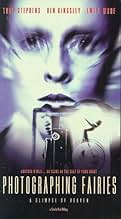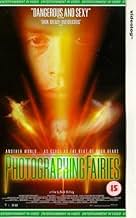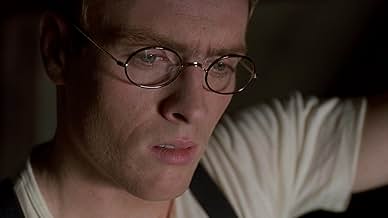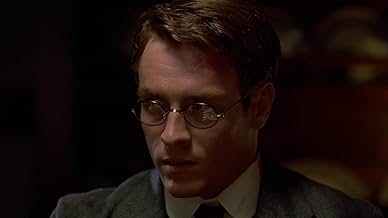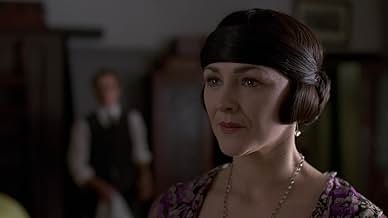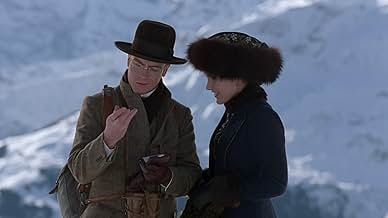अपनी भाषा में प्लॉट जोड़ेंPhotographer Charles Castle is dazed with grief after the death of his bride. He goes off to war and works in the trenches as photographer. After the war, still grieving, Charles receives so... सभी पढ़ेंPhotographer Charles Castle is dazed with grief after the death of his bride. He goes off to war and works in the trenches as photographer. After the war, still grieving, Charles receives some photographs that claim to be of fairies.Photographer Charles Castle is dazed with grief after the death of his bride. He goes off to war and works in the trenches as photographer. After the war, still grieving, Charles receives some photographs that claim to be of fairies.
- निर्देशक
- लेखक
- स्टार
- पुरस्कार
- 5 जीत और कुल 3 नामांकन
फ़ीचर्ड समीक्षाएं
The music was a subtle treasure throughout the movie. Its main theme is played as everything from a dance tune to a funeral dirge, and it will stay with you far after the movie. It is that `haunting' quality of the tune that adds that extra ethereal touch to the total effect of the movie. The 'death song' is a part of Beethoven's Seventh Symphony, and has been recorded by Sarah Brightman as Figlio Perduto. The movie has definite religious undertones. Photographing Fairies makes no distinctions about beliefs. The preacher-father character is the pastor for a small church, and the heaven ideas can be adapted to suit almost any taste. Its challenge is to the basis of belief itself, and begs to ask a single daunting question "What if heaven were as real as a place?" Much of the magic that makes Photographing Fairies such a resounding success is the elements of love / death / and the longing to recapture ones state of personal grace. A feeling of redemption as real and achievable as the magic of a child's innocence. No matter what your philosophical/religious beliefs are, you will be moved by what you feel in this movie. Its touching message will compel you to view this movie over-and-over again.
The central concern of the film, that of seeing, or not seeing (or perhaps more perhaps *comprehending*, or not - is established in the opening shot of the film: the blurred face of Castle alone in the group photograph he takes of his wife and others. In an image which anticipates those of the fairies later on, he is the one blurred, here the 'ghost' on his film. Appropriately, in a film full of echoes and symbols, this long shot out from Castle's wife's iris recalls his later, obsessive, photographic enlargement of another eye: that of one of the girls photographed with fairies.
The death of his wife then reduces Castle further, through grief and shock, to a state almost like that of a somnambulist. He walks through life, hovering between the shades, oblivious to fear and the concerns of the real world - as evidenced by the unexploded bomb he encounters without any sense of danger, ticking like the time piece he keeps to remember his wife. Castle doesn't care. He wants to die - a sense of foreboding which stays with the viewer from the beginning to the end of the film. He even 'photographs the dead' in his studio, witnessed by his work for the soldier's parents. Even when a new sexual relationship becomes a possibility, later in the film, he cannot rejoin this aspect of life though spiritual malaise.
This thread is continued later in the scene later where Castle enters the church to hear a sermon by the bereaved Kingsley. Earlier that morning he has taken the flower-drug and has 'died' watching the fairies. Now he appears, bloodied like a victim in Macbeth, as the pale ghost at the ceremony..
Castle's attempt to photograph fairies, spirits who hover between life and death, is obviously an attempt to capture something back from the spirit world that has captured his wife. Such is the delicacy and subtlety of the films structure and symbolism, however, that at the end one could feasibly argue that Castle actually died with his wife on the mountain and - rather like in The Occurrence At Owl Bridge Creek - what has happened since the opening scenes has just been the dream of a dying man!
Performances are generally excellent (although Ben Kingsley's wig and stare are slightly disconcerting). Those who found the actual fairies disappointing in effect were perhaps expecting something grander. Some of Castle's hallucinations reminded me of Jacob's Ladder and Kingsley's demise of the killer's suicide in Peeping Tom.
As a last instance of the film's care with presentation and sophistication, one may take the music. The chief elements that reoccur are a sombre dirge like bass-motif and a light waltz. Only at the end of the film does recognise that the bass-motif is an altered element of the famous Beethoven slow movement which plays throughout the last few scenes. Like Castle himself, it is transfigured - or 'completed' by events.
Toby Stephens plays Charles Castle (Stephens to me has some strikingly similar traits to Hugh Grant), who tragically lost his wife on the Swiss Alps. The movie chronicles his struggles to come to grips with her death and how the possibility of an afterlife (I don't wish to give the story away)makes him obsessed to prove that there is such an afterlife.
I was impressed by Stephens in this movie and am sure that bigger things will come his way. I was also impressed with Emily Woof who plays the romantic (if that can be said) support to Stephens. Woof was very good in the Woodlanders and continues her fine form here.
Ben Kingsley is also commanding in the movie and his counternance to Stephens desire to prove the existence of the fairies is the keystone of the movie's conclusion.
I tend to like movies that have story lines that I have not come across before. This is one such movie. The pleasing aspect is that the acting supports the plot which leads to a pleasant viewing experience.
This movie gets my thumbs up 7/10
क्या आपको पता है
- ट्रिवियाEdward Hardwicke (Sir Arthur Conan Doyle) has played Doyle's Dr. Watson many times.
- गूफ़When discussing the original photograph with Beatrice Templeton (Frances Barber), Charles Castle (Toby Stephens) says that the supposed fairy in the image could just be a 'glitch in the emulsion'. The use of the word 'glitch' is anachronistic. Glitch, meaning a small fault, didn't come in to common parlance till the 1960s some 40+ years after the setting of this film.
- भाव
Gardner: Everyone of you here, ladies and gentlemen, has something in common, something that links you to your neighbor. We are all of us searching for a clue that shows us what life truly promises us, for a way of seeing what lies under the simple surface of things. Now recently, we've had continued messages at seances, messages indicating that a visible sign was coming through. Ladies and gentlemen, that sign is here. People talk about the miracle of photography. I'm going to show you a photograph of a miracle.
- कनेक्शनVersion of BBC2 Play of the Week: Fairies (1978)
- साउंडट्रैकSymphony No. 7 Op. 92 II. Allegretto
Written by Ludwig van Beethoven
Performed by The Philharmonia Orchestra
Conducted and orchestrated by Terry Davies
टॉप पसंद
- How long is Photographing Fairies?Alexa द्वारा संचालित
विवरण
- चलने की अवधि
- 1 घं 46 मि(106 min)
- रंग
- ध्वनि मिश्रण
- पक्ष अनुपात
- 1.85 : 1

